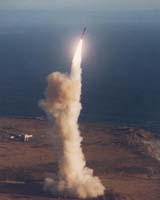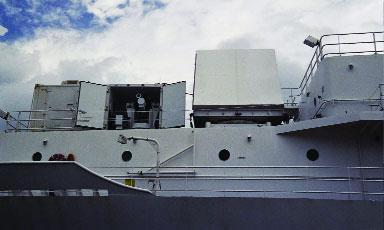Lockheed Martin Missiles and Space Systems

Under a series of contracts with Lockheed Martin Missiles and Space Systems, FORTH, Inc. participated in the design and did the full implementation of the firmware for the Master Controller unit in the S-Band Mobile Array Telemetry (SMART) phased array antenna, which has been successfully deployed at sea aboard the USNS Pathfinder and other Navy support ships. We also supported this project with design and implementation of enhancements and refinements based on data collected from missions at sea.
The deployment and operation of the SMART antenna (incl. antenna controllers) is summarized in this excerpt from a Lockheed Martin press release:
A U.S. Navy missile telemetry tracking antenna developed by Lockheed Martin supported a recent U.S. Air Force extended range flight test of a Minuteman III intercontinental ballistic missile, demonstrating its flexibility for a variety of missions. Telemetry data were acquired with the S-Band Mobile Array Telemetry (SMART) antenna as the unarmed missile traveled approximately 5,100 nautical miles from Vandenberg Air Force Base, Calif., to a predetermined target in the Pacific Ocean near Guam.

The Navy operated the SMART antenna, which is part of the Navy’s Mobile Instrumentation System, aboard the oceanographic survey ship USNS Sumner (T-AGS-61). The antenna system acquired and collected radio frequency data on the missile’s performance. The Navy collected the data under an inter-service agreement with the Air Force to evaluate Minuteman III performance. Additionally, Lockheed Martin formatted the data for Air Force use in compliance with the Strategic Arms Reduction Treaty.
“The Navy has been using this antenna system for Trident II D5 telemetry data collection for more than four years,” said Bob Ghani, senior manager, Fleet Ballistic Missile flight test and evaluation, Lockheed Martin Space Systems Company. “The system’s versatility has enabled the Navy to support the Air Force not only in the Minuteman III test flight, but also in space launch tracking.”
Developed to track test launches of the Navy’s Trident II D5 Fleet Ballistic Missile, the SMART antenna system can be deployed on any one of five Naval Oceanographic support ships that are used to support ballistic missile flight tests. The entire system can be installed on a ship and operational within a few hours. A standard 8-by-20-foot shelter contains receiver and recorder subsystems, test equipment, antenna control interfaces, the operator console and workstations.
Lockheed Martin delivered the SMART antenna system to U.S. Navy Strategic Systems Programs in 2002. Since then, the Navy has saved an estimated $2 million a year by reducing the need for telemetry aircraft during evaluation tests of the Trident II D5 missile. With a 1,100-nautical-mile range, the system operates in the 2,200- to 2,400-megahertz short-band. The system scans its entire field of view (120 degrees azimuth and 80 degrees elevation) in less than three-tenths of a second and can simultaneously track up to eight independent objects. Self-calibrating electronics overcome ship roll and pitch motion without gyro stabilization, and phased-array technology enhances signal reception. The system’s modular design uses commercial, off-the-shelf components and can be reconfigured for other sea-based, land-based and airborne applications.
